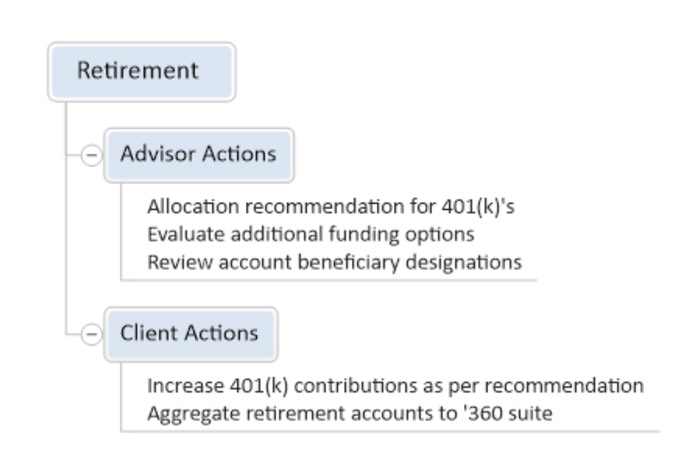Does Your Financial Plan Fit on 1 Page? It Should. Here's How.
Software planning tools can be handy, but they can also be complex and end up steering you in the wrong direction. What may work better? A little face time with your planner, leading to a simple, easy-to-follow financial "map."


Have you found your financial plan has fallen short of providing you the clarity and confidence you were hoping for? If so, your feelings may be due in part to how your plan was built. Maybe the plan is too complex … or just too impersonal. There’s a solution for this, and it’s definitely not high-tech. It’s a good, old-fashioned conversation.
Many financial advisers use software tools to build their plans. The crux of a software-based financial plan is the information that has been input. Most financial planning programs typically offer a generous range for inflation, rate of return, mortality age, percentage of current income needed at retirement and the probability (%) of achieving your financial goals as some examples.
Once your financials are entered and these inputs are selected, the software generates a plethora of modules that can be included in your plan. You and your adviser will then typically meet and discuss your current situation in comparison to your ideal. As the client, you’re probably excited to see these projections — “Can I buy that dream house in five years?”

Sign up for Kiplinger’s Free E-Newsletters
Profit and prosper with the best of expert advice on investing, taxes, retirement, personal finance and more - straight to your e-mail.
Profit and prosper with the best of expert advice - straight to your e-mail.
This is where the adviser-client conversation can become challenging. For example, if the plan “paints” an optimistic picture of your future, this could provide a false sense of security. If you request that your adviser lower the rate of return used, increase inflation and extend your mortality age by five years — wham — your plan now paints a totally different picture just by the click of a few buttons on a keyboard.
Sure, there will be those plans that still “paint” optimism even with very conservative inputs, but that’s not necessarily the norm.
A Nice, Long Talk Will Take You Far
As the co-founder of an advisory firm in Upstate New York, we feel planning is more art than science. We have found that intimate conversations centered around what is most important to clients about their money often yields invaluable answers that can serve as raw material for creating financial solutions for them.
Everyone has different plans or ideas for using their money. When you and your adviser are both clear as to yours, you can together begin building a “map” of sorts, which can provide clarity and direction for your financial life. Complexity isn’t a prerequisite for sound planning.
You can often share more about what you are trying to do or accomplish in 60 minutes of quality conversation with your adviser than through a 10-page data-intake form.
To this end, my business partner, Dennis Coughlin, and I have both have had experiences where our recommendations were vastly different for clients who had very similar personal and financial demographics. This happens as a result of knowing specifically what is trying to be accomplished.
2 Seemingly Similar Clients End Up with Very Different Plans
For example, I recently met with two couples who have very similar income levels and assets. They are also close in age. So the data entered into the typical software planning program would certainly look similar. The primary difference between them is something a software program would have a harder time picking up on: their lifestyle aspirations.
Couple No. 1 want to spend time with family, enjoy their home, travel twice per year and enjoy their community. Couple No. 2 want to spend eight months per year in Florida, gift annually to their kids and join the most expensive golf club in their hometown when home during the summer months.
As you may have guessed, Couple No. 1 can expect to retire earlier than Couple No. 2.
Anatomy of a Plan
So, while software has its place in financial planning, I prefer a more personal approach. After discussions with clients, my partner and I draw up a simplified financial planning map for them. It comes with plenty of room for notes, action items and tweaks over time. Here’s an example of what the basic framework of one client’s map might look like:

The map outlines some common areas we typically explore with clients. Depending on the scope of work, there might be five to 10 actionable items for each financial area. The lifestyle component is dynamic and typically includes many of the personal areas most important to each client (these often change from client to client).
If I use the retirement branch of the map as an example, here is an abbreviated version of what it might look like:

As time passes, adjustments are made where necessary to assure the map continues to provide good coordinates as to their desired financial destination. The financial climate changes, their health can change, their intentions can change too. The map focuses on what we can control rather than what we cannot.
Take the Next Step
If you find yourself feeling confused and overwhelmed as to where your retirement plan is headed, have a sincere conversation with your adviser about those feelings. Ask him or her to provide you a helicopter view of all the moving parts of your plan. This may help you get a better sense of clarity while reducing financial stress.
We’re living in a world where information comes at us from various directions at warp speeds. The concept of less being more can be appealing … in many areas of life.
Disclaimer
Branch address: 139 Genesee St., New Hartford, NY. Securities and advisory services offered through Commonwealth Financial Network, Member FINRA/SIPC, a Registered Investment Adviser.
Get Kiplinger Today newsletter — free
Profit and prosper with the best of Kiplinger's advice on investing, taxes, retirement, personal finance and much more. Delivered daily. Enter your email in the box and click Sign Me Up.

Chris Giambrone is a co-founder of CG Capital™, a boutique wealth management firm based in New Hartford, N.Y. He is a CERTIFIED FINANCIAL PLANNER™ and Accredited Investment Fiduciary® (AIF®). Chris has also earned a Certificate in Retirement Planning from the Wharton School of Finance at the University of Pennsylvania.
-
 Stock Market Today: Stocks Struggle Amid Tariff Uncertainty
Stock Market Today: Stocks Struggle Amid Tariff UncertaintyBoeing dropped after China suspended new aircraft orders, while Bank of America and Citi climbed on earnings beats.
By Karee Venema
-
 Starbucks 2025 Dress Code Changes: See the New Look
Starbucks 2025 Dress Code Changes: See the New LookThe 2025 Starbucks dress code change features a uniformed look as part of creating a more familiar and friendly cafe experience.
By Sean Jackson
-
 Should You Hire a Public Adjuster for Your Insurance Claim?
Should You Hire a Public Adjuster for Your Insurance Claim?As natural disasters strike more often, insurance clients are asking, 'What should I do, or who should I hire, if my insurance company is jerking me around?'
By H. Dennis Beaver, Esq.
-
 Tips to Help Entrepreneurs Create Self-Sustaining Businesses
Tips to Help Entrepreneurs Create Self-Sustaining BusinessesWith the right processes and people in place, a truly sustainable business can be efficiently passed on to a successor and run profitably on its own.
By Jason L Smith, CEP®, BPC
-
 Navigating Annuity Taxation: A Guide for Financial Advisers
Navigating Annuity Taxation: A Guide for Financial AdvisersUnderstanding the essentials of taxation in retirement income strategies involving annuities helps ensure positive outcomes for clients.
By Jake Klima
-
 How Google Reviews Can Help (or Hurt) Financial Advisers
How Google Reviews Can Help (or Hurt) Financial AdvisersDon't leave your Google Business Profile unclaimed — someone else can make changes if they claim it. Also, here's what you can (and cannot) do with the reviews.
By Jeff Briskin
-
 How Baby Boomers and Gen Xers Are Redefining Retirement Living
How Baby Boomers and Gen Xers Are Redefining Retirement LivingBoth generations need to embrace change and leverage real estate as a dynamic asset in their retirement planning. Here's how financial advisers can help, too.
By David Conti, CPRC
-
 How Good Advisers Manage Risk in Challenging Markets
How Good Advisers Manage Risk in Challenging MarketsThey understand the difference between what might be real challenges to an investor's strategy and fear brought on by market volatility.
By Ryan L. Kirk, CFA®
-
 Financial Planning's Paradox: Balancing Riches and True Wealth
Financial Planning's Paradox: Balancing Riches and True WealthWhile enough money is important for financial security, it does not guarantee fulfillment. How can retirees and financial advisers keep their eye on the ball?
By Richard P. Himmer, PhD
-
 A Confident Retirement Starts With These Four Strategies
A Confident Retirement Starts With These Four StrategiesWork your way around income gaps, tax gaffes and Social Security insecurity with some thoughtful planning and analysis.
By Nick Bare, CFP®